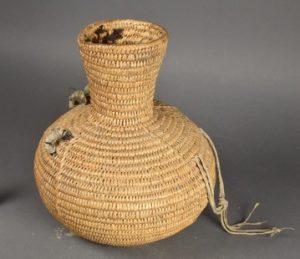Guidelines in Action: Museum of Indian Arts and Culture and Jicarilla Apache Baskets
In 2017 the Indian Arts Research Center at the School for Advanced Research first published a new resource known as the Guidelines for Collaboration. Drawing from decades of case studies and three years of focused work with Native and non-Native museum professionals, cultural leaders, and artists, the Guidelines provide a series of methods for how museums and source communities can work together across two-way learning opportunities. Today the Guidelines are used in classrooms, museums, cultural institutions, tribal communities, and elsewhere.
Guidelines in Action is a series of guest posts highlighting stories from the field.
Guest post by Sophie Hunter, Former Samuel H. Kress fellow, Museums of New Mexico conservation unit, a museum resources department with the Museum of Indian Arts and Culture, Santa Fe, NM
No Institution should ignore the chance to meet with Native communities to discuss their cultural heritage, especially when there are Guidelines that walk one through how to plan, communicate, and follow through on collaborations in a step by step way. —Sophie Hunter

Water jar with pine pitch coated interior. Jicarilla Apache. Museum of Indian Arts and Culture, 23547/12
In 2018, I began a project supported by a grant from the Foundation of the American Institute for Conservation, and funded by the Samuel H. Kress Foundation, to develop a conservation plan for the large collection of Jicarilla Apache pitch-coated baskets at the Museum of Indian Arts and Culture in Santa Fe, New Mexico. The baskets could not be handled safely because the pitch. Some were over 100 years old, dried out, and had pitch actively falling off of the baskets.
Although I am trained extensively in best-practice conservation methods, I am not a basket maker, nor am I Jicarilla Apache, and so I could not answer several questions culturally specific question that would have led the conservation of the baskets in completely different directions. Specifically, does the “life” or “spirit” stitching down the sides of the baskets mean that I should leave the baskets alone, let them live their life, and deteriorate? Would it be more appropriate to should stabilize the stitching so that each basket would have a longer life? Would it be desirable to reactivate the pitch–a process that would make the baskets look glossy again, as they likely appeared when first made, or would it be important to maintain the aged, grayish patina, that shows age and use? Is the grayish accretion specific to these baskets important to the source communities in some way?
With these questions in mind, and no obvious book to reference for the answers, we began to explore the best ways to seek out basket makers and source community members who would know the traditions and who could provide guidance in making the best, culturally sensitive decisions for the Collection.
One of my supervisors, Landis Smith, encouraged me to use a website publication she co-facilitated, the IARC’s Guidelines for Collaboration. She suggested that the Guidelines could provide me with more experience organizing a community visit. The Guidelines for Collaboration walked me through the process of reaching out to members of the Jicarilla Apache Nation and organizing a visit to discuss the baskets. The visit resulted in a more informed preservation plan that included the perspectives of a group of basket makers and community leaders who were critical to the project. I believe the Guidelines helped to make everyone feel more prepared and respected. We had two meetings, and as we continue to improve on the stewardship of the Jicarilla Apache collection, we see the efforts as a positive start to developing a long-term relationship between the conservation staff and the community. No Institution should ignore the chance to meet with Native communities to discuss their cultural heritage, especially when there are Guidelines that walk one through how to plan, communicate, and follow through on collaborations in a step by step way.
Learn more about the Guidelines for Collaboration here.
SIGN UP FOR THE SAR MONTHLY NEWSLETTER and stay up to date on our projects and programs.
